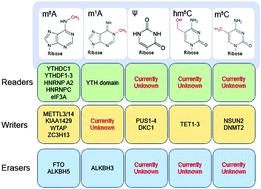当前位置:
X-MOL 学术
›
Mol. Omics
›
论文详情
Our official English website, www.x-mol.net, welcomes your
feedback! (Note: you will need to create a separate account there.)
Unraveling the RNA modification code with mass spectrometry.
Molecular Omics ( IF 3.0 ) Pub Date : 2020-03-10 , DOI: 10.1039/c8mo00247a Richard Lauman 1 , Benjamin A Garcia
Molecular Omics ( IF 3.0 ) Pub Date : 2020-03-10 , DOI: 10.1039/c8mo00247a Richard Lauman 1 , Benjamin A Garcia
Affiliation

|
The discovery and analysis of modifications on proteins and nucleic acids has provided functional information that has rapidly accelerated the field of epigenetics. While protein post-translational modifications (PTMs), especially on histones, have been highlighted as critical components of epigenetics, the post-transcriptional modification of RNA has been a subject of more recently emergent interest. Multiple RNA modifications have been known to be present in tRNA and rRNA since the 1960s, but the exploration of mRNA, small RNA, and inducible tRNA modifications remains nascent. Sequencing-based methods have been essential to the field by creating the first epitranscriptome maps of m6A, m5C, hm5C, pseudouridine, and inosine; however, these methods possess significant limitations. Here, we discuss the past, present, and future of the application of mass spectrometry (MS) to the study of RNA modifications.
中文翻译:

用质谱法解开 RNA 修饰密码。
蛋白质和核酸修饰的发现和分析提供了功能信息,迅速加速了表观遗传学领域的发展。虽然蛋白质翻译后修饰 (PTM),尤其是组蛋白上的蛋白质翻译后修饰 (PTM),已被强调为表观遗传学的关键组成部分,但 RNA 转录后修饰已成为最近引起人们兴趣的主题。自 20 世纪 60 年代以来,已知 tRNA 和 rRNA 中存在多种 RNA 修饰,但对 mRNA、小 RNA 和诱导型 tRNA 修饰的探索仍处于起步阶段。基于测序的方法对该领域至关重要,它创建了 m 6 A、m 5 C、hm 5 C、假尿苷和肌苷的第一个表观转录组图谱;然而,这些方法具有很大的局限性。在这里,我们讨论了质谱 (MS) 在 RNA 修饰研究中的应用的过去、现在和未来。
更新日期:2020-03-10
中文翻译:

用质谱法解开 RNA 修饰密码。
蛋白质和核酸修饰的发现和分析提供了功能信息,迅速加速了表观遗传学领域的发展。虽然蛋白质翻译后修饰 (PTM),尤其是组蛋白上的蛋白质翻译后修饰 (PTM),已被强调为表观遗传学的关键组成部分,但 RNA 转录后修饰已成为最近引起人们兴趣的主题。自 20 世纪 60 年代以来,已知 tRNA 和 rRNA 中存在多种 RNA 修饰,但对 mRNA、小 RNA 和诱导型 tRNA 修饰的探索仍处于起步阶段。基于测序的方法对该领域至关重要,它创建了 m 6 A、m 5 C、hm 5 C、假尿苷和肌苷的第一个表观转录组图谱;然而,这些方法具有很大的局限性。在这里,我们讨论了质谱 (MS) 在 RNA 修饰研究中的应用的过去、现在和未来。











































 京公网安备 11010802027423号
京公网安备 11010802027423号